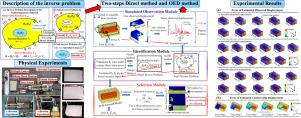A direct method to identify Young’s moduli and boundary conditions of the heterogeneous material
IF 7.1
1区 工程技术
Q1 ENGINEERING, MECHANICAL
International Journal of Mechanical Sciences
Pub Date : 2024-10-17
DOI:10.1016/j.ijmecsci.2024.109777
引用次数: 0
Abstract
Identifying unknown Young’s moduli and boundary conditions of the heterogeneous material using locally observed boundary data is the inverse problem which is generally solved by iterative methods. In this paper, a two-steps direct method is proposed for the first time to solve this inverse problem without iterations. The proposed method innovatively decomposes the heterogeneous elasticity inverse problem to two homogeneous elasticity sub-inverse problems. The single-data and multiple-data based direct methods are applied to identify background Young’s modulus and displacement boundary conditions, while the Maxwell–Betti principle based direct method and the equivalent boundary force based direct method are proposed to identify Young’s moduli of inclusions. In addition, an optimal experimental design method with a goal-oriented criterion is proposed to improve the accuracy of the two-steps direct method by optimizing the force application positions in observation data acquisition. Both numerical and physical experiments were conducted. The results demonstrate the feasibility of the proposed two-steps direct method and its optimal experimental design method.

确定异质材料杨氏模量和边界条件的直接方法
利用局部观测到的边界数据确定异质材料的未知杨氏模量和边界条件是逆问题,一般采用迭代法解决。本文首次提出了一种无需迭代的两步直接法来解决这一反问题。所提方法创新性地将异质弹性反问题分解为两个同质弹性子反问题。应用基于单数据和多数据的直接方法来确定背景杨氏模量和位移边界条件,同时提出了基于 Maxwell-Betti 原理的直接方法和基于等效边界力的直接方法来确定夹杂物的杨氏模量。此外,还提出了一种具有目标导向准则的优化实验设计方法,通过优化观测数据采集中的施力位置来提高两步直接法的精度。实验同时进行了数值和物理实验。结果证明了所提出的两步直接法及其优化实验设计方法的可行性。
本文章由计算机程序翻译,如有差异,请以英文原文为准。
求助全文
约1分钟内获得全文
求助全文
来源期刊

International Journal of Mechanical Sciences
工程技术-工程:机械
CiteScore
12.80
自引率
17.80%
发文量
769
审稿时长
19 days
期刊介绍:
The International Journal of Mechanical Sciences (IJMS) serves as a global platform for the publication and dissemination of original research that contributes to a deeper scientific understanding of the fundamental disciplines within mechanical, civil, and material engineering.
The primary focus of IJMS is to showcase innovative and ground-breaking work that utilizes analytical and computational modeling techniques, such as Finite Element Method (FEM), Boundary Element Method (BEM), and mesh-free methods, among others. These modeling methods are applied to diverse fields including rigid-body mechanics (e.g., dynamics, vibration, stability), structural mechanics, metal forming, advanced materials (e.g., metals, composites, cellular, smart) behavior and applications, impact mechanics, strain localization, and other nonlinear effects (e.g., large deflections, plasticity, fracture).
Additionally, IJMS covers the realms of fluid mechanics (both external and internal flows), tribology, thermodynamics, and materials processing. These subjects collectively form the core of the journal's content.
In summary, IJMS provides a prestigious platform for researchers to present their original contributions, shedding light on analytical and computational modeling methods in various areas of mechanical engineering, as well as exploring the behavior and application of advanced materials, fluid mechanics, thermodynamics, and materials processing.
 求助内容:
求助内容: 应助结果提醒方式:
应助结果提醒方式:


